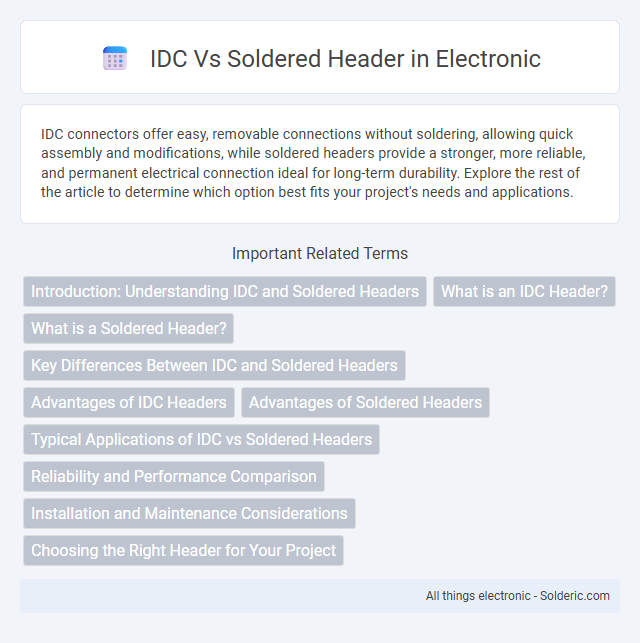IDC connectors offer easy, removable connections without soldering, allowing quick assembly and modifications, while soldered headers provide a stronger, more reliable, and permanent electrical connection ideal for long-term durability. Explore the rest of the article to determine which option best fits your project's needs and applications.
Comparison Table
| Feature | IDC Connector | Soldered Header |
|---|---|---|
| Connection Type | Insulation Displacement Contact (press-fit) | Permanent soldered joint |
| Installation | Quick ribbon cable press-fit, no soldering required | Requires manual or automated soldering |
| Reliability | Moderate, can loosen under vibration | High, strong mechanical and electrical bond |
| Rework Capability | Easy to disconnect and reconnect | More difficult; requires desoldering |
| Typical Applications | Prototyping, modular assemblies | Permanent setups, high-reliability devices |
| Cost | Lower initial cost, less labor | Higher assembly cost due to soldering |
| Signal Integrity | Good for standard signals | Better for high-frequency or sensitive signals |
Introduction: Understanding IDC and Soldered Headers
IDC headers offer quick, reliable connections by clamping wires into slots without soldering, making them ideal for rapid prototyping and easy replacements. Soldered headers provide a permanent, durable connection by securing wires with molten metal, ensuring stable electrical contact in long-term applications. Choosing between IDC and soldered headers depends on your project's need for flexibility versus lasting stability.
What is an IDC Header?
An IDC (Insulation Displacement Connector) header is a type of connector designed for flat ribbon cables, enabling quick, reliable connections without stripping insulation from individual wires. It features sharp blades inside the connector that pierce the cable insulation to establish contact with the conductor, ensuring consistent electrical connectivity. IDC headers are commonly used in electronics for easy, solderless cable connections, offering efficient assembly and maintenance compared to soldered headers.
What is a Soldered Header?
A soldered header is a type of connector used in electronics where pins are permanently affixed to a printed circuit board (PCB) through soldering, ensuring a stable electrical connection. Unlike IDC (Insulation Displacement Connector) headers, soldered headers require manual soldering, providing a more secure and durable attachment suitable for high-vibration environments. Commonly made from brass or phosphor bronze with a tin or gold plating, soldered headers are widely used in prototyping and custom electronics projects.
Key Differences Between IDC and Soldered Headers
IDC headers provide a quick and reliable way to connect ribbon cables without soldering, using an insulation displacement mechanism that cuts through the wire insulation. Soldered headers require manual soldering of individual wires or components, offering a more permanent and electrically robust connection. While IDC headers are preferred for rapid assembly and ease of replacement, soldered headers excel in environments demanding higher mechanical stability and long-term durability.
Advantages of IDC Headers
IDC headers provide quick and reliable connections without soldering, reducing assembly time and errors in electronic projects. Their insulation displacement technology allows consistent electrical contact by piercing wire insulation, enhancing signal integrity and durability. These connectors enable easy modifications and maintenance, making them ideal for prototyping and field repairs.
Advantages of Soldered Headers
Soldered headers provide a more secure and reliable electrical connection compared to IDC connectors, reducing the risk of intermittent contact or signal loss in your projects. The permanent bond created by soldering enhances durability, making soldered headers ideal for environments with vibration or mechanical stress. This method also offers improved conductivity and lower resistance, ensuring optimal performance in high-frequency or sensitive electronic applications.
Typical Applications of IDC vs Soldered Headers
IDC headers are commonly used in applications requiring quick, reliable connections without soldering, such as ribbon cable assemblies for computer peripherals, networking equipment, and internal PC connections. Soldered headers offer robust, permanent connections ideal for embedded systems, industrial equipment, and prototype boards where durability and electrical integrity are critical. Your choice between IDC and soldered headers should consider the need for ease of installation versus long-term mechanical stability in the intended application.
Reliability and Performance Comparison
Soldered headers provide superior reliability compared to IDC connectors due to permanent, solid metal-to-metal connections that resist vibration and corrosion over time. IDC connectors offer quick installation but can experience contact degradation under mechanical stress and thermal cycling, impacting signal integrity. Performance-wise, soldered headers maintain stable electrical conductivity and lower contact resistance, crucial for high-frequency or high-current applications.
Installation and Maintenance Considerations
IDC connectors offer quick, tool-less installation by simply pressing the wire into the connector, making them ideal for fast assembly and easy maintenance. Soldered headers require precise soldering skills and equipment, resulting in a more permanent and reliable connection but complicating repairs or modifications. Your choice depends on whether ease of installation or long-term durability is the priority for your project.
Choosing the Right Header for Your Project
Selecting the right header for your project depends on factors such as ease of installation, durability, and signal integrity. IDC headers offer quick, reliable connections without soldering, ideal for prototypes or temporary setups, while soldered headers provide stronger mechanical stability and better long-term electrical performance for permanent assemblies. Consider your project's need for reusability, mechanical stress, and precision to decide between the convenience of IDC and the robustness of soldered headers.
IDC vs Soldered Header Infographic

 solderic.com
solderic.com